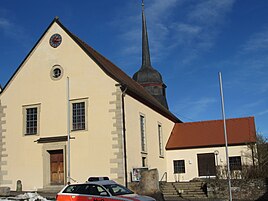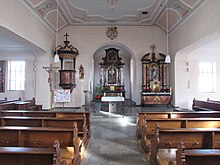Kothen (moths)
|
Kothen
community moths
Coordinates: 50 ° 22 ′ 13 ″ N , 9 ° 45 ′ 55 ″ E
|
|
|---|---|
| Height : | 399 m |
| Residents : | 600 |
| Incorporation : | May 1, 1978 |
| Postal code : | 97786 |
| Area code : | 09748 |
|
The Catholic St. Matthew in Kothen
|
|
Kothen is a village in Lower Franconia that belongs to the Motten community in the Bad Kissingen district.
geography
Kothen is located in the Franconian Rhön , just before the Bavarian-Hessian border. Embedded in the wide river valley of the Kleine Sinn , south of the Rhine-Weser watershed , the settlement extends in the shadow of the Pilster basalt rock . The carbonated mineral water of the Pilster spring at its foot, also popularly called Sauerbrönn, is said to have a scientifically unconfirmed healing effect.
Former districts
Today's unofficial former districts of Kothen were:
- Oberdorf (district)
- Unterdorf (district)
- Eckendorf (district)
- Quackhof (district)
- Eisenhammer (hamlet)
Naming
A monk named Koto took a liking to the region south of the city of Fulda in the 8th century and settled there with his entourage. This is why the settlement was called zum Kotten until the 18th century . Over time, the current place name Kothen developed from this .
history
Kothen was first mentioned in 1127, when the Benedictine Gerlach von Thulba donated his land in Kothen to the Fulda Abbey . Originally it formed an independent municipality with the Quackhof and Maria Ehrenberg as well as the hamlets Dörrenberg , Eisenhammer and Schmelzhof. Dörrenberg was cleared and destroyed in 1938 when the Wildflecken military training area was built . Maria Ehrenberg was spared this fate only through luck and the commitment of the then artillery officer Friedrich Dollmann. On May 1, 1978, Kothen was incorporated into the community of Motten.
religion
Kothen is a Catholic village. The church was built in 1753 under the Fulda abbot Amand von Buseck , which is evidenced by the coat of arms above the chancel. However, there was a church in the village before, as the bell tower that still exists is older than the rest of the building. The substructure of the tower points to the 15th to 16th centuries. Until the liturgical reform of the Second Vatican Council, the altar was on the ground floor of the old choir tower . It is probably related to the origin of the pilgrimages to Maria Ehrenberg .
The patron saint of the church was originally St. Nicholas , today's late baroque church St. Matthew is consecrated to the evangelist Matthew .
Originally Kothen belonged to the parish of Oberleichtersbach . In 1512 a priest was appointed for the localities of Kothen and Werberg . The pilgrimage to Maria Ehrenberg , which at that time already belonged to the municipality of Kothen, began to flourish. Soon afterwards, Kothen and Werberg were incorporated into the Motten parish. Speicherz , which previously belonged to the parish of Bad Brückenau , was placed under the pastoral care office of Kothen in 1940. After long efforts, Kothen was declared an independent parish in 1954 with the Speicherz branch and the Maria Ehrenberg pilgrimage church. Since February 10, 2010 the parish of Motten and the parish of Kothen with the Speicherz branch and the pilgrimage church Maria Ehrenberg have been combined in the parish community Maria Ehrenberg . The name was determined by a vote of the faithful. With 70 votes, this name prevailed against Unter dem Maria Ehrenberg (2), Zu Füssen Mariens (11) and Um den Maria Ehrenberg (20).
Soil monuments
See: List of soil monuments in Motten (Bavaria)
Culture and customs
A special tradition in Kothen goes hand in hand with the so-called Querchstuhl ( querch : from Middle German for: quer ). This is an oversized chair of wood to which a bottle of high-percentage alcohol is fixed. If a person is referred to as querch (ie: quer ), he is considered to be unfounded opinionated, contentious or unreasonable. In order to appease such troublemakers and prevent disputes , a so-called cross chair is set up at festive events . If a person is then identified as querch or if there is a difference of opinion , the person or parties involved must take a seat on the Querch chair in order to sit out their quarrels or drink them together. Not every troublemaker necessarily takes a seat on the cross chair . If he refuses or is prevented for other reasons, it can happen that the chair is placed in front of the front door at a later point in time in order to signal to every passer-by that the resident of this house has been found to be querch .
economy
In the past, the economy in Kothen was mainly characterized by iron processing . However, when ore mining in the Rhön came to an end, this industry was a thing of the past. Only the hamlet of Eisenhammer and the Schmelzhof still remind of this time. Today wood processing is the main economic driver of Kothens. However, there are also declines in production. Citizens' jobs are increasingly shifting to the cities. There is a campsite with a swimming lake in Kothen .
Infrastructure
Kothen has traffic connections to the neighboring towns of Motten and Speicherz through the federal road 27 . It is connected to the Kalbach district of Heubach via a local road across the Bavarian-Hessian border . The place is only isolated from the east by the Wildflecken military training area. The Franconian Marienweg runs through Kothen .
Educational institutions
- Kindergarten Kothen (formerly elementary school)
Museums
- The Werberger Stube gives an insight into everyday life in the Rhön and deals with the history of the isolated village of Werberg .
literature
- Michael Mott : The secret of the "white woman" / "Säuerlinge" near Kothen and Oberriedenberg, in: Fuldaer Zeitung , July 28, 1994, p. 12 (series: DENK-mal!).
- Michael Mott: The "Bronn" and the white woman / Where our little fountains flow: To a mysterious water dispenser near Kothen / Relief of ailments, in: Fuldaer Zeitung, Nov. 3, 1998, p. 18 (series: Where our little fountains flow) .
Web links
- Kothen . In: Motten-Touristik.de
Individual evidence
- ^ Federal Statistical Office (ed.): Historical municipality directory for the Federal Republic of Germany. Name, border and key number changes in municipalities, counties and administrative districts from May 27, 1970 to December 31, 1982 . W. Kohlhammer GmbH, Stuttgart and Mainz 1983, ISBN 3-17-003263-1 , p. 739 .
- ↑ Werberger Stube. In: Motten.de. Retrieved December 28, 2017 .
- ↑ Last remains of an old village. In: inFranken.de. April 28, 2011, accessed December 28, 2017 .


